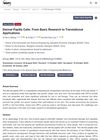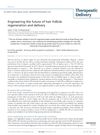The Secret Life of the Hair Follicle
February 1992
in “
Trends in genetics
”
TLDR Hair follicles create different cell layers and proteins, controlled by various molecules.
The mammalian hair follicle, composed of uniform epithelial and mesenchymal cells, was found to produce multiple concentric cylinders of distinct cell types, each synthesizing unique proteins. Evidence suggested that various growth factors, cell adhesion molecules, and other molecules played crucial roles in regulating this complex organ.







